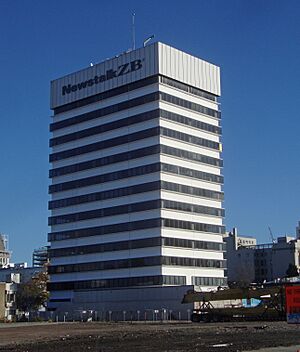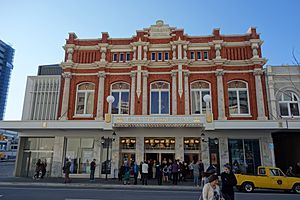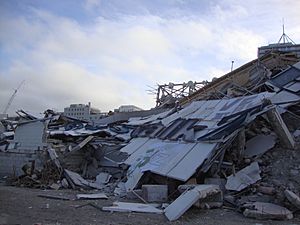Implosion of Radio Network House facts for kids
The implosion of Radio Network House in 2012 was a really big deal for New Zealand. It was the very first time a building in the country was demolished using an implosion! This method makes a building collapse inwards on itself.
This event was a "test case" to see if implosions could be used for other buildings in Christchurch Central City. Many buildings there were badly damaged by the 2011 Christchurch earthquake. Radio Network House was one of them, beyond repair. The Canterbury Earthquake Recovery Authority (CERA) decided it needed to come down.
In July 2012, it was announced the building would be imploded. A special company from the United States, with lots of experience, was brought in to help.
The chance to push the button for the implosion was even put up for auction online! It became one of the most-watched auctions on Trade Me. A group of demolition companies won the bid for NZ$26,000. They let the Child Cancer Foundation choose a six-year-old boy from Queenstown to trigger the event.
The implosion was watched carefully to see if this demolition method would work well for future projects. It went perfectly! People hoped this would lead to more implosions in New Zealand, especially in Christchurch. However, as of 2020, only one more building has been imploded since.
Contents
About Radio Network House
Radio Network House was a tall office building. It had 14 floors and stood about 61 meters high. It was built in 1986. You could find it at 155 Worcester Street in Christchurch.
For its last 12 years, Greg Hedges owned the building. It was first used as the Christchurch studio for Television New Zealand (TVNZ). Many popular TV shows for kids were filmed there. These included What Now, After School, and The Son of a Gunn Show.
TVNZ moved out in late 1998. Later, a phone company called Telstra New Zealand owned the rights to put their name on the building. After they joined with another company to form TelstraClear, their logo was displayed. Finally, The Radio Network bought the naming rights. The building was then called Radio Network House. At the time it was demolished, the logo of Newstalk ZB was on the building.
The Canterbury area was hit by many earthquakes. The office building was too damaged to fix after the 2011 Christchurch earthquake on February 22, 2011. Before the earthquakes, about 400 people worked in the building. After the quakes, the Canterbury Earthquake Recovery Authority (CERA) was created to help with the recovery.
Getting Ready for Implosion
On August 30, 2011, CERA added Radio Network House to the list of buildings to be torn down. On July 17, 2012, a local newspaper, The Press, announced that CERA had approved the implosion. A press conference was held the same day. Companies involved and CERA talked to the media.
The main company for the demolition was Naylor Love. They hired Ceres New Zealand for the implosion. Ceres then worked with Controlled Demolition, Inc.. This American company is a world leader in implosions. They have done about 9,000 implosions!
The implosion of Radio Network House was a test. This was because many tall buildings in Christchurch still needed to be demolished. This method had never been used on New Zealand buildings before. It was a challenge for Controlled Demolition, Inc. New Zealand buildings are built to resist earthquakes. This means they have much more reinforcing steel than buildings they usually demolish.
Before demolition, workers remove everything from inside buildings. This includes things like internal walls. It is cheaper to have 'clean' demolition material. Holes were drilled into the building's support columns. These holes were filled with about 60 kilograms of explosives. When set off, these explosives would destroy the supports. This would make the building collapse.
A representative from Ceres said the implosion would save about six weeks of demolition time. It would also save money. The implosion cost about NZ$1 million. A traditional demolition would have cost about NZ$1.2 million. The building owner's insurance covered the costs.
Some people had concerns about the implosion. The owner of a nearby building worried about ground shaking. He also worried about dust and possible damage to his new building. His original building was destroyed in the 2010 Canterbury earthquake. These worries were dismissed by the demolition companies. The threatened court action did not happen.
The Auction for the Button
Soon after the implosion was approved, there was talk of auctioning off the right to push the button. The money would go to charity. The auction was set up on the internet site Trade Me. It started on Tuesday, July 24, at 11 am. It had a $1 starting price.
The auction became very popular. Within one hour, bids reached $6,000. Bidding went up to $30,000. However, some bids were not real. Trade Me staff removed them. Some bidders also asked to be removed.
When the auction ended, it had been viewed 459,420 times. This was the third highest number of views for a Trade Me auction. The winning bid was $26,000. It came from a group of eight demolition companies. These companies were working on demolitions in Christchurch. They gave the right to choose who pushed the button to the Child Cancer Foundation. The foundation chose a six-year-old boy from Queenstown.
The money from the auction went to the Canterbury Earthquake Heritage Buildings Fund. This fund then gave the money to the Isaac Theatre Royal. This is a historic building in Christchurch. The Government of New Zealand promised to double donations for restoring heritage buildings. So, the Isaac Theatre Royal received NZ$52,000 in total. The restored theatre reopened in November 2014.
The Implosion Day
The day before the implosion, demolition companies told people to stay away. They advised watching on TV or the internet for safety. Several TV stations had live broadcasts. The Press newspaper said they would post a video online. A safety zone was set up. No one was allowed within about 200 meters of the building.
Despite the warnings, thousands of people gathered on the street. It was Sunday morning, August 5. At exactly 8 am, a series of short explosions were heard. A few seconds later, another series of explosions followed. The building collapsed towards the north, just as planned. The implosion manager said it went a bit further than he hoped, but he was lucky. The explosions could be heard all around Christchurch.
One goal for CERA in approving the implosion was to study the soil. Radio Network House was built on some of the worst soil in Christchurch. Measurements showed the ground moved only 12 millimeters per second. This is like a large truck slowly driving across the site. This showed that poor soils would not be a problem during implosions. This made it easier for other building owners to get approval from CERA. More implosions were expected. However, only the Christchurch Central Police Station has been imploded since, in May 2015.
The implosion caught attention worldwide. Media in Australia, Canada, Ireland, South Africa, and the United States covered the event.





